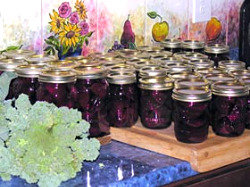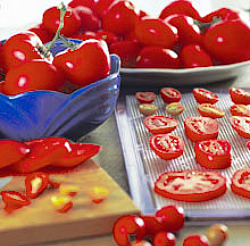
You can store all the fresh tastes from your garden for winter by canning, freezing, and drying.
You don't have to have a large garden to get overwhelmed by too much produce. Even novice gardeners will notice that vegetables and herbs can produce much more than they can use in one meal or even within a week. Of course, I always encourage people to take their excess produce to family, friends, or even the local food shelf. But in most parts of the country, the bounty is short lived. Winter means little production from the vegetable garden, so to enjoy all your hard work during the dark, cold, snowy months, why not preserve the harvest?
Storing Fresh VegetablesWhile preserving vegetables usually means canning, freezing, and drying, you certainly can store vegetables fresh in a cool basement or garage. However, unless you have the right conditions for each type of vegetable in terms of temperature, ventilation, and humidity, their shelf life will be limited.

Canning beets, beans, and tomatoes is a good way to store these vegetables safely through winter.
Many vegetables can be stored in a cool cellar or refrigerator if you know what they need. Certainly a root cellar would be ideal, but here are some easier ways to keep your fresh produce into the winter.
If you don't have the space or proper conditions to preserve your garden bounty fresh, try freezing. It's one the easiest methods of preserving the harvest. If you're only freezing small batches of tomatoes, pesto, beans, or corn, then your refrigerator freezer should be fine. However, for a few hundred dollars you can purchase a chest freezer and really go to town. Ours is filled not only with vegetables from our garden, but berries, bread, soups, and sauces. You'll be amazed at how much you can store in a large freezer.
The key with freezing is to blanch the vegetables properly. Blanching preserves their nutrients and keeps them crisp when they come out of the freezer. Blanching requires you to dip vegetables for only a few minutes into boiling water, then into an ice water bath to stop the cooking process. Dry off the vegetables, place them into freezer bags, and you're done. You can process lots of vegetables by freezing in little time.
I like to make batches of prepared foods such as pesto and tomato sauce to freeze as well. It's great to be able to just pop these into a dish in winter for a fresh tasting treat. I use the ice cube tray method for freezing pesto. Place fresh pesto in ice cube trays, cover in plastic overnight. Pop the cubes of pesto out of the trays in morning and store them in freezer bags. It takes up little space and the cubes make a nice size portion for a single meal.
Canning
Tomatoes can be dried in a warm oven. Meaty paste varieties such as 'Roma' are easiest to dry.
For the more adventurous gardener, canning is an old art that's making a comeback. I remember helping my mother can tomatoes each summer. She learned from her mother and I'm sure the chain of canners goes back generations in Italy where my grandmother was from.
Canning requires more equipment and time than freezing. It's best to have a large pot or canner for boiling water, canning jars with lids and caps, and special tongs for pulling the canned jars out of the boiling water. If you plan on canning low-acid vegetables such as beans, you'll need to invest in a pressure canner in order to preserve them safely; foods high in acidity such as tomatoes and pickles can be processed safely in a boiling water bath. You have to follow specific directions for each vegetable so it's best to get a reliable book such as Putting Food By by Janet Greene and follow the proper steps. There is the risk of botulism if you can incorrectly. But don't let that scare you. I've canned for years within any problems.
Certain vegetables, such as canned tomatoes, pickled okra or cucumbers, and dilly beans, have a special flavor that even fresh versions of these vegetables can't match. You can also can blended vegetables such as salsa, relishes, and juices. My mother-in-law makes a special juice she calls "V-8" made out of tomatoes and any other vegetables she has in excess. She cooks them down and cans the juice. It's a delicious and nutritious drink to have in mid-winter.
I find canning the most fun done with others, in the evening, with the music blaring, and maybe a beer or glass of wine. It's social event that takes some hours, so settle in and have some fun with it.
DryingDrying vegetables is probably the least popular of the preserving methods, but can be pretty easy in hot, sunny, dry climates like southern California or if you own a dehydrator. Tomatoes are one of the more popular vegetables to dry, but you can also try onions, leeks, potatoes, and zucchini. Care has to be taken to make sure they dry thoroughly without spoiling. Usually it's a matter of slicing the vegetables thinly, cooking or blanching them depending on the vegetables, laying them on a sheet or drying rack not touching, and placing them in the sun (in the right climate), dehydrator, or oven turned onto a low (100F) temperature. It often takes all day to dry vegetables. Unlike freezing and canning, you can store lots of dried vegetables in glass jars without taking up much space, in any cool spot in the house for months.
 Charlie Nardozzi is an award winning, nationally recognized garden writer, speaker, radio, and television personality. He has worked for more than 30 years bringing expert gardening information to home gardeners through radio, television, talks, tours, on-line, and the printed page. Charlie delights in making gardening information simple, easy, fun and accessible to everyone. He's the author of 6 books, has three radio shows in New England and a TV show. He leads Garden Tours around the world and consults with organizations and companies about gardening programs. See more about him at Gardening With Charlie.
Charlie Nardozzi is an award winning, nationally recognized garden writer, speaker, radio, and television personality. He has worked for more than 30 years bringing expert gardening information to home gardeners through radio, television, talks, tours, on-line, and the printed page. Charlie delights in making gardening information simple, easy, fun and accessible to everyone. He's the author of 6 books, has three radio shows in New England and a TV show. He leads Garden Tours around the world and consults with organizations and companies about gardening programs. See more about him at Gardening With Charlie.
 Victory Seed Company has all the seeds you want for your best garden in 2024.
Victory Seed Company has all the seeds you want for your best garden in 2024.
For 25 years, the family-owned Victory Seed Company has provided the highest quality vegetable, herb and flower seeds to families across the country. We are passionate about providing you the best seeds available that give excellent germination, robust plants, and the harvest you want. With a catalog of over a thousand varieties, we have everything, and our prices are the kinds that we'd want to pay. We have hundreds of yesterday's heirloom vegetables, as well as today's award winning hybrid selections. Get to know us by visiting our website and browsing through our online vegetable seed catalog.